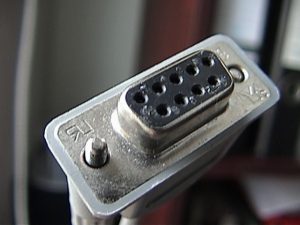
Sometimes it’s hard to believe that old technology can still be of great value. COM ports are a vivid example of such an “old-school” technology that retains its place in the modern world. Since the beginning of the digital era, they seem to have served as a reliable bridge between computers and external devices such as printers, scanners, and other peripherals.
A time travel back to the 1960s reveals the beginning of the history of port COM. At a time when computers were huge and took up entire rooms, the need for an efficient way to communicate between different devices became obvious. COM ports were the answer to this need, offering a method of data transmission that was not only reliable but also understandable to technicians of the time.
These ports, also known as serial communication ports, allowed information to be transmitted serially, bit by bit, over small cables. This was a major breakthrough, because until then, many communication tasks required complex and voluminous solutions.
Of course, COM ports are far from the fastest by modern standards, but their simplicity and reliability have made them indispensable in many situations, especially in industry and critical applications, where stability is more important than speed.
They reveal to us not only the history of technology, but also the history of innovation, showing how sometimes “old friends” can stay with us and adapt to new challenges and needs.
It was in the 1960s, the era when computers were beginning to be actively used in commercial and scientific applications, that the need for a standardized interface for connecting external devices arose. Computers of that time were large and difficult to use. They required special equipment for reading data, such as punch cards and magnetic strips. The problem was that different manufacturers were using their own, incompatible systems to connect peripherals, and this made it difficult to exchange data and integrate equipment.
In response to this need, the RS-232 standard was developed (described in detail in another article). So, in short, first introduced in 1960, RS-232 became one of the first universal interfaces for data transfer. The standard described the way data could be transferred between a computer and peripheral devices using serial communication. This standard allowed for connections at a distance of up to 15 meters, which was a significant achievement for the time – the ability to provide reliable and very stable data transmission over relatively short distances. It was easy to connect devices such as printers, mice, modems, and other equipment to personal computers and large computer systems. In addition, the use of a standardized port simplified the integration of equipment from different manufacturers, contributing to the development of the computer industry.
Significance for the development of computer technology
The early introduction of COM ports was of great importance for the development of computer technology. This technology formed the basis for the development of many future communication and interface standards, showing the importance of standardization and universality in technological progress.
During the 1970s and 1980s, with the development of personal computers, COM ports became even more popular. They were an important part of the early PCs, in particular the IBM PC.
In addition to connecting to peripherals, COM ports are widely used in industry and research. They were used to collect data from various sensors, control machines and automated systems. Their reliability and simplicity make them the ideal choice for critical applications that require stable and uninterrupted operation.
Gradual decline in popularity
With the advent of USB in the late 1990s, the popularity of COM ports began to decline. USB offered faster data transfer speeds, connectivity, and the ability to support a large number of devices through a single port. Despite this, COM ports still remain important in some specialized and industrial applications where their reliability and simplicity have no alternative.
The whole remarkable story of the COM ports is a story of innovation, adaptation and resilience. They witnessed the birth of the computer age, its development and transformation. Although the modern technological space offers faster and more convenient ways of communication, COM ports still find their place where reliability and simplicity are valued.

